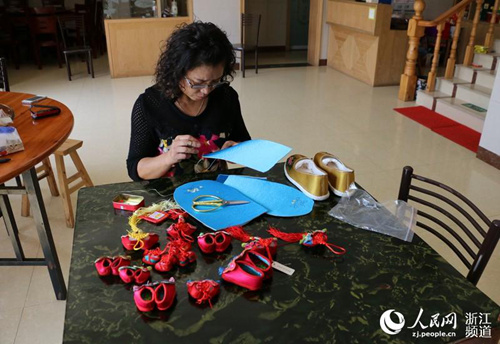When Poverty Meets Tourism
chinagate.cn by Liu Hui, April 1, 2016 Adjust font size:
 |
|
Ma Genying, a villager from Tonglu County in east China's Zhejiang Province, makes traditional Chinese embroidered shoes as a way to support pro-poor tourism. [People's Daily Online] |
A Full Participation Project
In October of 2015, China launched a project that could both develop rural tourism and transfer social resources to enrich the locals' lives. Jointly organized by the State Council Leading Group Office of Poverty Alleviation and Development (LGOPAD) and other governmental organizations, the project is aimed at conducting targeted poverty reduction activities for registered poor villages with preferential financial policies while guiding them with targeted support for featured tourism industries. For example, those registered poor villagers would be supplied with micro-credit loans with a maximum amount of 50,000 yuan (U.S. $7,720).
By the end of 2014, 28,000 poor villages were registered across China. 6,130 villages in China were ranked as pro-poor tourism pilot centers. Those villagers will no longer be poverty stricken after being officially approved for the establishment of pilot centers.
In July of 2015, a charity event centered on pro-poor tourism kicked off with the help of the CNTA. According to the CNTA, it will mobilize all qualified tourism development and planning centers while helping 560 promising villages shake off poverty. Figures released by the CNTA show that a total of 223 tourism planning centers have taken part in the charitable actions.
"Participating in the pro-poor tourism project is not only our burden or our corporate social responsibility (CSR), but also helps create a win-win situation for all parties involved," said Dr. Liu Feng, a chief adviser working for a tourism development company headquartered in Beijing.
Dr. Liu also implied that his company had prepared to cooperate with three poor villages. One, located in central China's Hunan Province, has already been well developed. Liu explained the targeted plan for tourism development, such as, starting holiday village resorts featuring Miao ethnic culture, establishing modern agricultural parks to promote agritourism, training locals to serve the tourism industry and help the villages achieve their goals.
"The tourism development centers should make targeted measures to redefine their strategies with a clear goal, because keeping abreast of those villages' development will exert a positive influence on their poverty reduction and alleviation. That is what the project requires," said Professor Li Xinjian, Vice Secretary-general of the China Tourism Reform and Development Advisory Committee.
Li maintained that rural villages were superior in natural resources and that they embraced unique cultural elements when compared to other artificial tourism resorts. Therefore, pro-poor tourism project seem much more suited to the particular needs of those villages.
Promising but Challenging Issue
Currently, China remains a developing country in terms of its huge population with more than 70 million people struggling against poverty. By 2020, 12 million people will rise out of poverty through developing tourism projects. This accounts for 17 percent of the poor in China based on an announcement from the CNTA and LGOPAD.
It is also predicted that 150,000 rural resorts will be established and 3 million rural tourism communities will be developed nationwide. Combined tourism incomes for locals will reach as high as 1 trillion yuan (U.S. $1,544 billion) annually as more than 2 billion visitors embark on their rural journeys. As a result, 50 million rural people will benefit from the sky-rocketing income and productivity that the given data has forecasted.
"Even though pro-poor tourism is picking up momentum, we should take a look at its limitations," urged Wang Yanyong, Director of Center for Recreation and Tourism Research at Beijing Jiaotong University, adding that unfavorable conditions plague local run-down facilities, inconvenient geographical locations as well as each region's initial resistance to change.
"Mostly, rural tourism has lost its own unique features and in some cases duplicated the traditional tourism model in product designs and tourist attractions. Consequently, it will waste local natural resources, and lose the appeal of urban visitors," Wang claimed.
Despite the thorny issues attributed to pro-poor tourism, China is still ambitious in promoting poverty reduction and alleviation with rural tourism as its platform.
Wang advocated that rural tourism requires scientific arrangement and systematic planning. The path of developing rural tourism should be advanced step by step, enlarging the scope of the pilot projects. Meanwhile, all of society's members from the central government to the locals should join in the ranks to promote pro-poor tourism.
According to Li Xinjian, targeted measures should be adopted to explore the value of rural tourism. He also pointed out that government officials and locals, in a long-term plan, should maintain their support of rural tourism. In addition, China should also take other poverty relief programs into consideration to promote the coordinated development of rural areas.